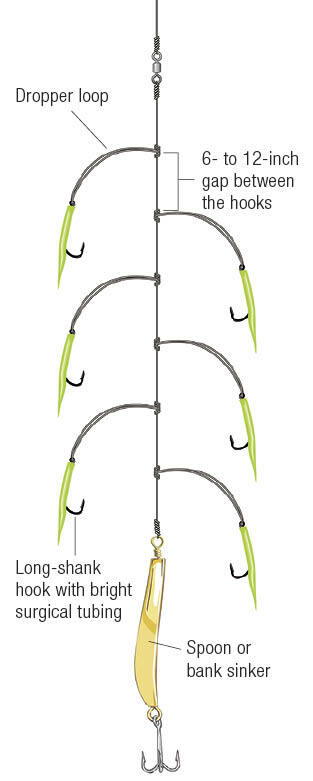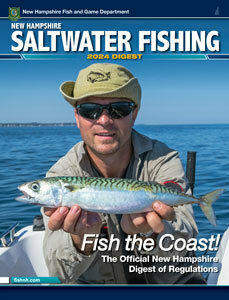Saltwater Rigging Basics
Chunk Bait Bottom Rig Setup
To create a setup that will allow you to present cut bait (herring, Atlantic mackerel, or clams) to predatory fish patrolling the surf:
- Attach a 3-way swivel to the main line using a clinch knot
- To the bottom-facing swivel ring, tie a stretch of monofilament (1 to 3 feet)
- To the end of this line, tie a pyramid sinker
- Tie your leader line and hook to the remaining swivel ring
This configuration will allow the bait to remain near the bottom where the pyramid sinker is resting, but the swells and current will pull the chunk bait a few feet up in the water column. By keeping the bait above the bottom, its movement imitates a swimming prey fish and helps to keep it out of reach of bottom-dwelling crabs and lobsters.
Hint: When fishing around rocky shorelines, use a lower pound test monofilament than the main line and leader, so that in the event of a snag in a rock crevice, only the weight is lost and will need to be retied.
Alternative floating setup: Helps keep crabs at bay. Tie a circle hook on your line, using a clinch knot. Attach a bobber about 3 feet above it. Clamp a small weight on the line in between, about a foot above the hook. Bait the hook with a live fish hooked through the lip or the back just below the dorsal fin.
Chunk Bait Bottom Rig

Mackerel Rig Setup
Atlantic mackerel are a common catch from shore or by boat in New Hampshire. This small schooling fish is great for bait, dinner or just some fun, and especially good as an introduction to saltwater fishing for younger anglers. Mackerel are commonly caught on “sabiki” rigs, and for mackerel, this typically consists of a 1 oz. diamond jig or spoon with a number of 1/0 size hooks above it, which can have colorful tubes or flies attached. These are easy to find “prefab” in coastal bait shops, but you can make your own using dropper loops on a leader. When jigged, these look like a school of smaller fish being chased by a bigger fish. If fishing from shore, cast the rig out and, after it settles, lift with a jerk, reel in, and repeat. When fishing from a bridge or boat, drop the rig down into the water, allowing it to go out of sight, 15-20 feet down. Jig it by lifting with a jerk and allowing it to settle before lifting again; if you are not getting any action, change the depth of the rig.
Mackerel Rig

Dropper Loop Knot (use to attach a second hook)

Use Circle Hooks
Non-offset corrodible hooks are mandatory to fish for striped bass, sharks, or bluefish if angling with bait.
To conserve fisheries, many sport anglers now release the fish they catch. Using circle hooks instead of standard J-hooks can significantly reduce mortality. Experienced striped bass anglers find that baited circle hooks, because the point is turned inward, almost always hook fish in the lip or jaw. Points on J-hooks, in contrast, are more exposed and can lodge in the gills, throat or stomach—internal organs where injuries can be fatal.
Because of its design, you don’t need to “set” a circle hook as you would a J-hook; simply let the fish “take” the bait and then start reeling to get a hook-up. Many longtime anglers believe they actually catch more fish with circle hooks than J-hooks, once they’ve learned to use them properly.

Let’s Go Fishing! Classes with N.H. Fish and Game
Want to learn how to fish, enhance your fishing skills, help turn a friend into a fishing buddy? Check out Let’s Go Fishing classes from N.H. Fish and Game’s Aquatic Resources Education team! Courses are offered throughout the state by trained volunteer instructors who bring a wealth of experience and knowledge to help anglers get started.
Courses for adults and children are free of charge and designed to teach basic ecological concepts, fishing skills, and new ways to enjoy the outdoors together. Courses cover basic techniques for year-round fishing in ponds, lakes, streams and the ocean. A typical course offers hands-on instruction, plus a field trip to put your new skills to the test on the water. Let’s Go Fishing also offers specialty clinics and weekend workshops on fly fishing, saltwater fishing, fly tying, ice fishing and more. For a class schedule, visit fishnh.com.

